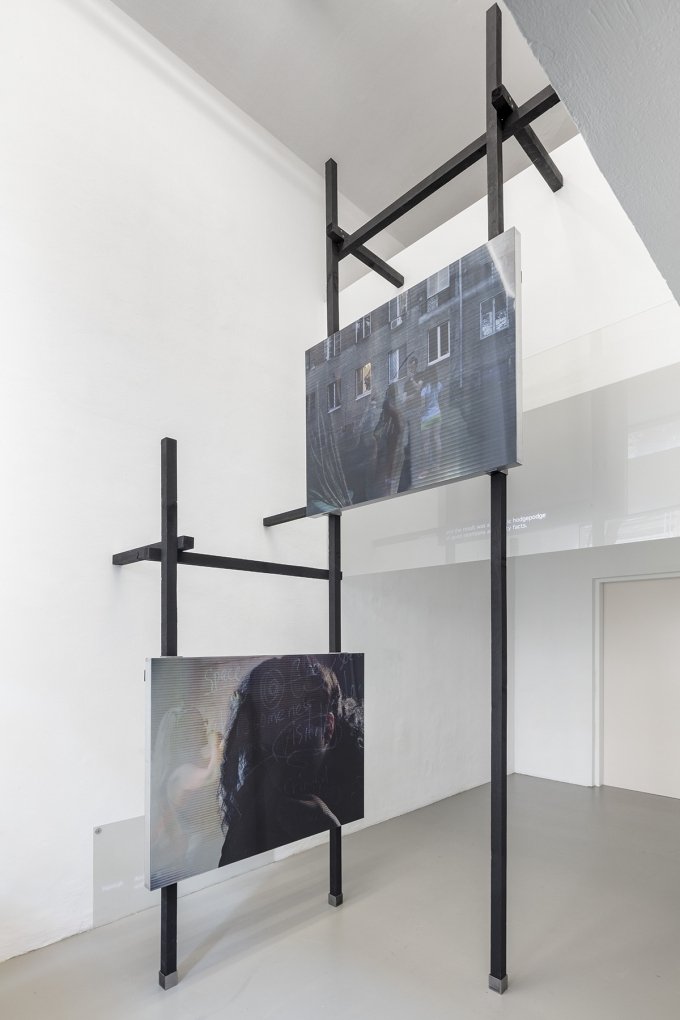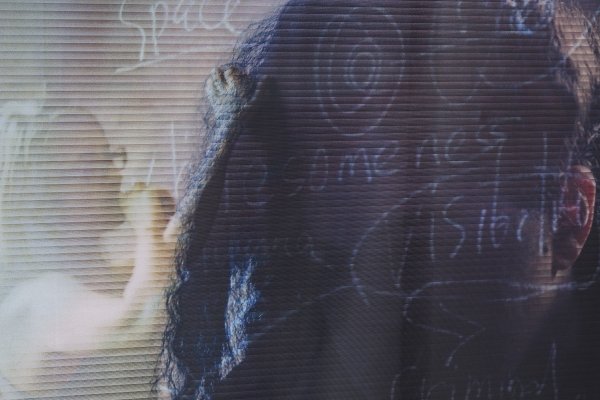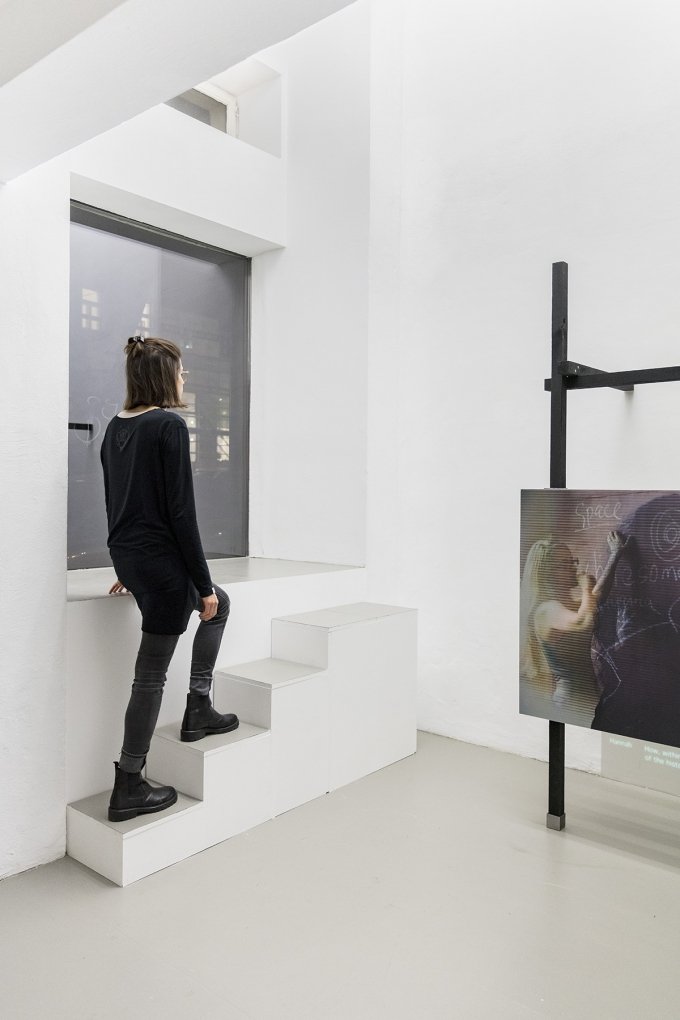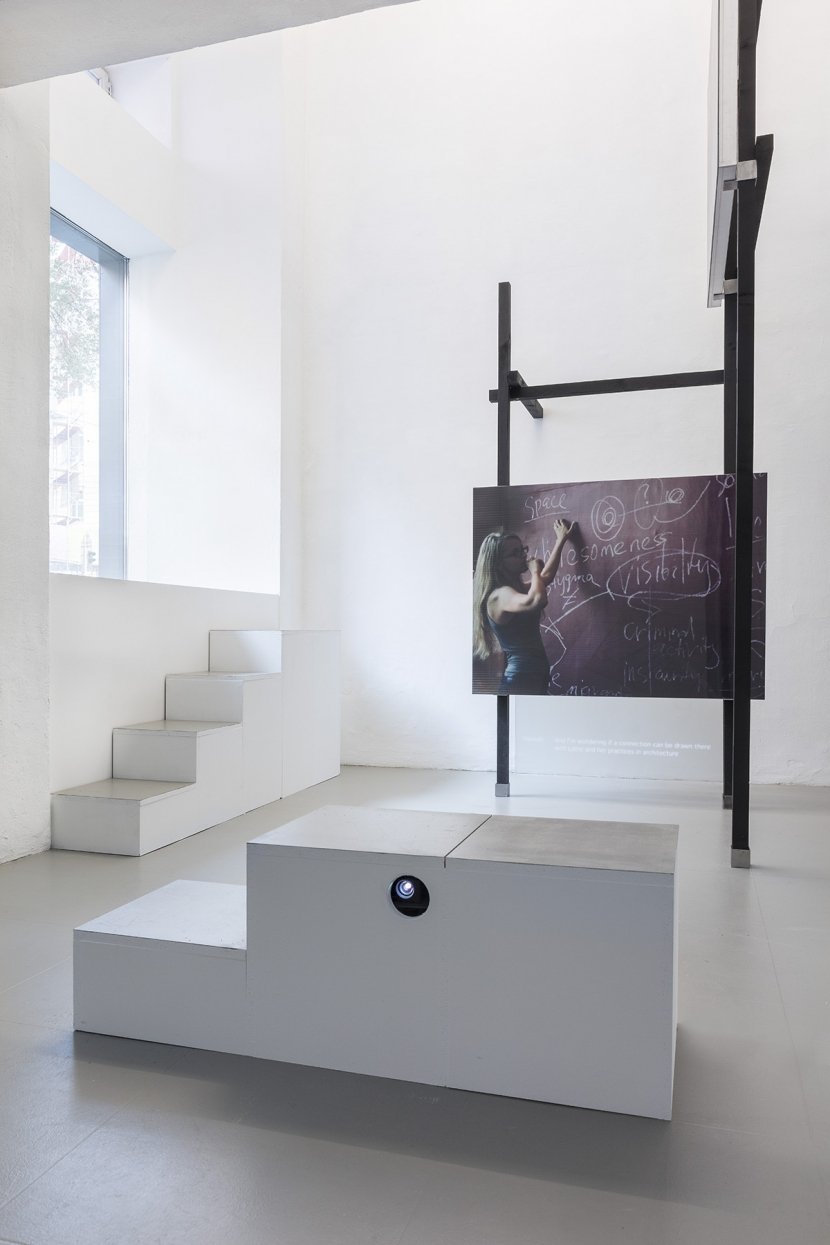Wendelien van Oldenborgh bei Significant Other, Wien
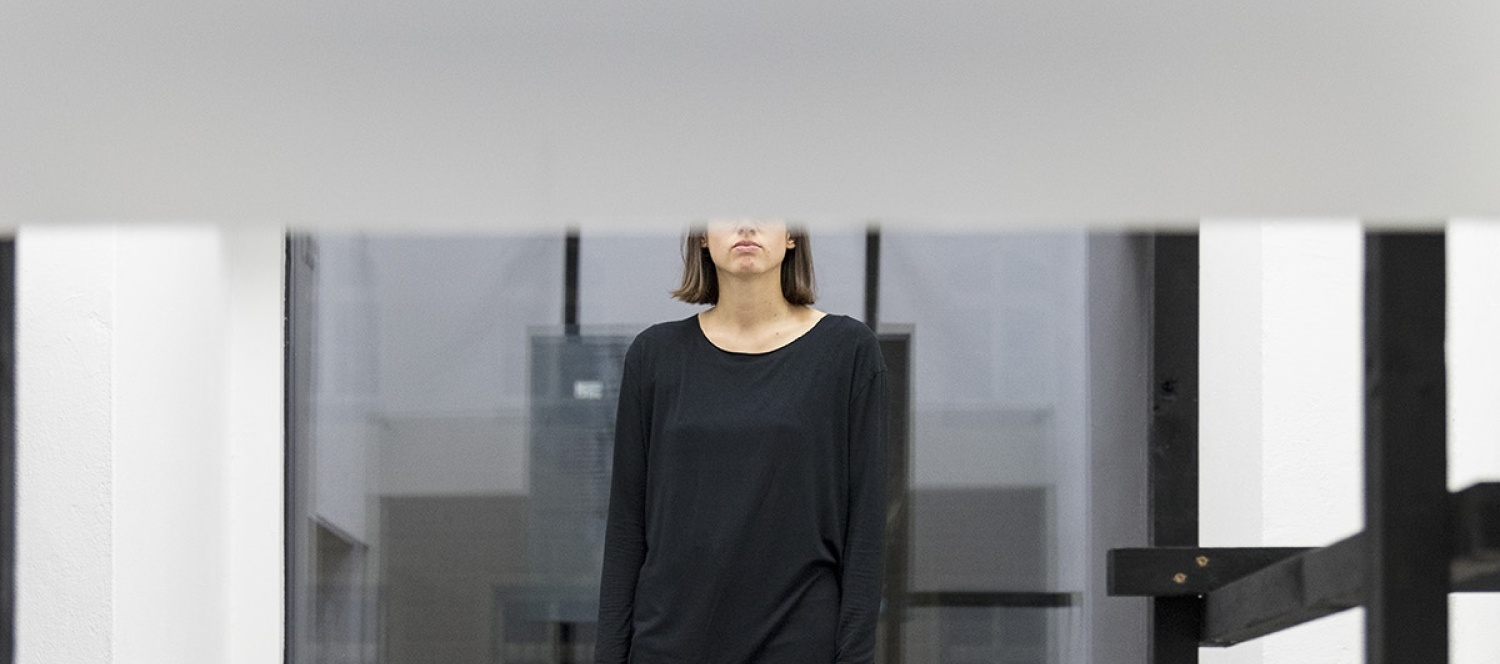
Significant Other
Burggasse 24, 1070 Wien
Österreich
KünstlerIn: Wendelien van Oldenborgh
Titel: Future Footnotes
Datum: 24. Oktober - 12. Januar 2018
Fotografie: All images courtesy of Significant Other | Photo: kunstdokumentation.com
Ausstellungstext:
The cinematic machine, lenticular prints and footnotes of a film as a contingency.
What constitutes a cinematic practice? How do we perceive it? And how are we used to understand it? Concerning artistic practice, we have witnessed a gradual transformation influenced by the development and democratization of available technology from video art to moving-image and most recently to time-based media. And if time has become of the essence - how do we perceive time? As a linear sequence with a beginning and an end or rather a never ending loop?
When it comes to traditional cinema, the former is still the case, even though the resurgence of TV, mainly through online streaming services changed pace and length radically in this field. Suddenly a story that used to unfold over the course of 90 minutes is transformed into a mushrooming array of episodes, weeks, seasons and months or - just as easily - a couple of days of binge-watching.
And so begins the erosion of the formerly dominant feature film practice. So-called “serious film directors” fluidly venture into TV formats, while the big screen gives space to showcases of new digital technologies manifested in brutally simple comic hero narratives, swarming with invading alien forces and fuelled by spectacular explosions born out of a green screen reality.
Artistic practice on the other hand follows its habit of antagonizing the mainstream, and so we observe a surge of artistic feature films, accompanied by the replication of cinematic conditions in the exhibition context or a shift towards a symbiotic coexistence of cinematic and installation practices.
Wendelien van Oldenborgh’s filmic practice has always been anchored in determined attempts to disturb the traditional narrative structures of film and perhaps in particular documentary formats. Her time-based experiences manifest themselves in complex support systems of architectural elements, and her actors often transgress otherwise precisely defined positions of director, actor but also scenography and soundtrack. More recently WvO introduced the format of “footnotes” as an additional explanatory tool to her films, such footnotes appear as condensed moving image sequences accompanying the main cinematic work, performing the same function as their text-based relatives, namely to further expand on relevant, if not crucial, aspects that nevertheless do not make their way into the ‘final product’.
Future Footnotes as a comprehensive installation therefore goes beyond the limits of a singular and physically anchored exhibition by pointing towards a film currently in-the-making, which will eventually be presented at Haus der Kulturen der Welt in Berlin in early 2019 within the framework of bauhaus imaginista.
Yet another recently developed strategy is the use of lenticular printing, a technology in which lenses are used to create printed images with the ability to change when viewed from different angles and was first introduced into Oldenborgh’s practice in the project “Cinema Olanda” for the Dutch pavilion at the Venice Biennial in 2017. Representing ‘the shortest film imaginable’ and consisting of only three independent yet merging images, which are successively revealed to the viewer through their literal but perhaps also metaphorical change of point of view. The passive observer is sucked into the cinematic installation becoming basically its own operator.
At Significant Other these two strategies of cinematic footnotes and lenticular printing merge to create an alternate way of perceiving film. Following the logic of the space the lenticular prints are produced to be viewed in a vertical movement, encouraged through the stair and bench shaped displays. Another familiar traditional cinematic element comes into play through projected subtitles. As the textual voices speak and enter into a dialogue, they create something akin to a storyline and connect not only different geographical and ideological places but also temporal ones, which allow the viewer to match them like a construction kit into different variations and combinations of a fragmented plot, hinting to the complete work, currently only existing as a contingency.
While heavily relying on thorough research and precisely following the real lives of underexposed characters that in many ways influenced Dutch public life - be it in the shape of whole urban neighbourhoods or doing pioneer political work - there is nevertheless a strong fictional aspect to the work as van Oldenborgh brings them together in ways that never could or would have taken place and pointing not only to their under-representation in a Dutch context struggling to find an honest post-colonial position but also proposing to question why these urgencies barely intersected when they have now become so clearly interwoven for instance in matters of migration and social housing?
Lastly the whole space is transformed into a film, into which the viewer is immersed. In apparent contradiction to commercial developments from 3D to 5D cinema, where you sit comfortably on your trembling armchair while being splashed with water and covered in smoke, here the senses are activated only one by one and according to your physical position and its changes. One could say that SO becomes a cinematic machine where narrative logic dissolves: initiating the visit with the ending titles on the facade, followed by a single film still shot framed by the shop window and opening up the miraculous world of cinema upon entering.
Lotte Stam Beese (*1903, Silesia, Germany - now Poland) was one of the first female Bauhaus-trained architects. After being prompted to leave the Bauhaus because of her amorous liaison to Hannes Meyer she embarks on a most remarkable trajectory that will lead her first to Berlin, Vienna and Brno and a brief stint in Moscow only to return to Brno for a while. Working for Bohuslav Fuchs and by now an pregnant out of wedlock of a child by Meyer, she will become actively engaged in leftist-communist politics and later practically apply her beliefs in building the so-called Sotsgorods in the Soviet Union from 1932 to 1934, where she also meets Mart Stam, whom she will marry and depart with to the Netherlands. In 1946 she is appointed urban-planning architect of Rotterdam where she will become most influential in designing complete city quarters integrating modernist ideas and communist-socialist notions alike, which were also largely discussed as urban design models at CIAM congresses of ’49 and’51. Beese will live and work until her retirement in 1968 and her death in 1988 in Rotterdam, where afterwards some of her urban developments will regain notoriety for becoming social hotspots - justly or not.
Hannes Meyer (*1889, Switzerland) was an architect and second director of renowned Bauhaus school from 1928 to 1930, where he introduced his radical functionalist philosophy named ‘Die neue Baulehre’. He was soon dismissed for allegedly politicizing school and students and emigrated to the Soviet Union along with several former students. Meyer taught, acted as an advisor and created plans to redevelop Moscow and possibly more importantly he was finally able to realize many of his ideas in a variety of scales ranging from interior design and furnishing, to construction of buildings and development of complete urbanist projects, mainly in the far east of the USSR. In 1936 Meyer will relocate to Geneva and in 1939 to Mexico, where he will live and work for 10 years before returning and staying in Switzerland until his death in 1954.
Hermina Huiswoud (*1905, British Guiana - now Guyana) migrates to New York in 1919 where she is active in various socialist and communist networks also associated with the Harlem Renaissance and in 1926 marries Otto Huiswoud, who had been born in Dutch Guiana - now Surinam - and was the only black founding member of the Communist Party of America. After the war the Huiswouds migrate to the Netherlands where they will establish a network of anti-colonial thinkers active in the fight against European and American imperialism who are in exchange with for instance the International Communists and other Caribbean Marxists. The Huiswouds would also edit and distribute the magazine ‘The Negro Worker’ and although dedicated and life-long pioneering activists concerned with the ‘Negro Question’ are to this day barely recognized.
Langston Hughes (*1902, US) is one of the most prominent black writers of the 1920’s and part of the Harlem Renaissance. Although harshly criticized by black intellectual contemporaries he was the most widely received poet and writer due to a style that was intensely subjective, passionate, sensitive to beauty and musicality but was perceived by many as unfavourably representing the black community. Full of racial pride, his work promoted equality, condemned racism and celebrated African American culture, humor and spirituality and in so doing also shaped literature and politics. Hugues was a close friend of the Huiswouds and especially of Hermina with whom he maintained an epistolary correspondence still available to us today.
Hannah Dawn Henderson (*1991, Scotland) is an artist and writer living and working in The Hague, Netherlands. Henderson’s work seeks to examine narratives surrounding the embodiment of diasporic heritage, colonial legacies, and the illegibility of identity. Henderson’s first book, Being, in a State of Erasure, was published in 2017 by Book Works, London, following a period of research into the archives of the National Council of Civil Liberties, supported by the Wilberforce Institute. Henderson’s approach of examining tensions and inequalities in society, through an informed but also openly subjective lens resonates with WvO’s strategies, for whom she conducted a thorough research of the demographics of Pendrecht, a neighbourhood in Rotterdam designed by Lotte Stam Beese, in order to challenge societal prejudices but also as a means to compare and initiate an exchange with its ‘sister-neighbourhood’ KhTZ in Kharkiv, Ukraine.
Ievgeniia Gubkina (*1985, Ukraine) is an architect, researcher of modernism, curator of architecture and art projects, educational events and activities. She co-founded the NGO Urban Forms Center and women‘s avant-garde movement Modernistki and is also researcher in the Center for Urban History of East Central Europe. She graduated from Kharkiv National Academy of Municipal Economy with a Master’s degree in urban planning. Gubkina has authored a number of publications and articles. Furthermore she is co-author of the study and book “Soviet Modernism. Brutalism. Post-Modernism. Buildings and Projects in Ukraine 1960–1990” - which will be released end of 2018. Gubkina grew up in KhTZ district of Kharkiv, which Lotte Stam Beese helped plan, and has intensively studied the neighbourhood from a professional but also personal angle not only focusing on architectural but rather social and political dimensions of an urban project of this scale and trajectory.

